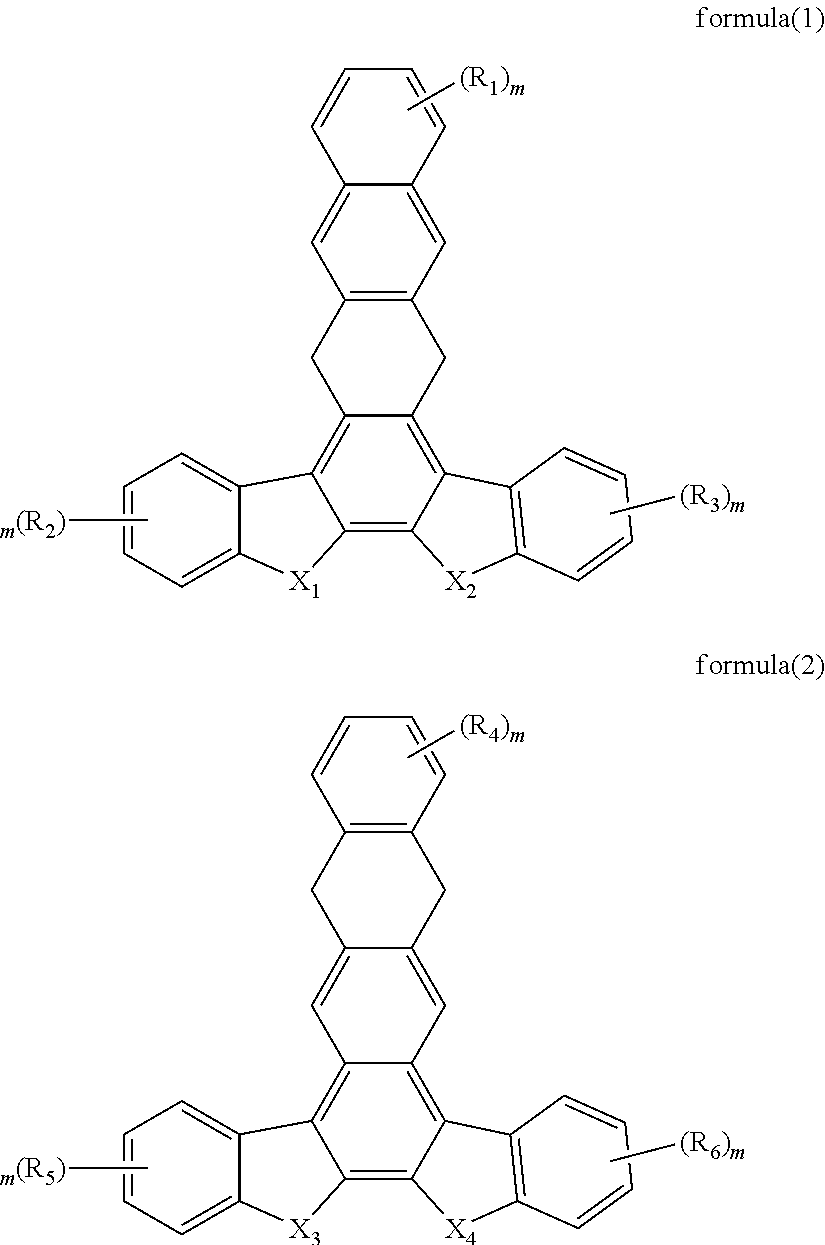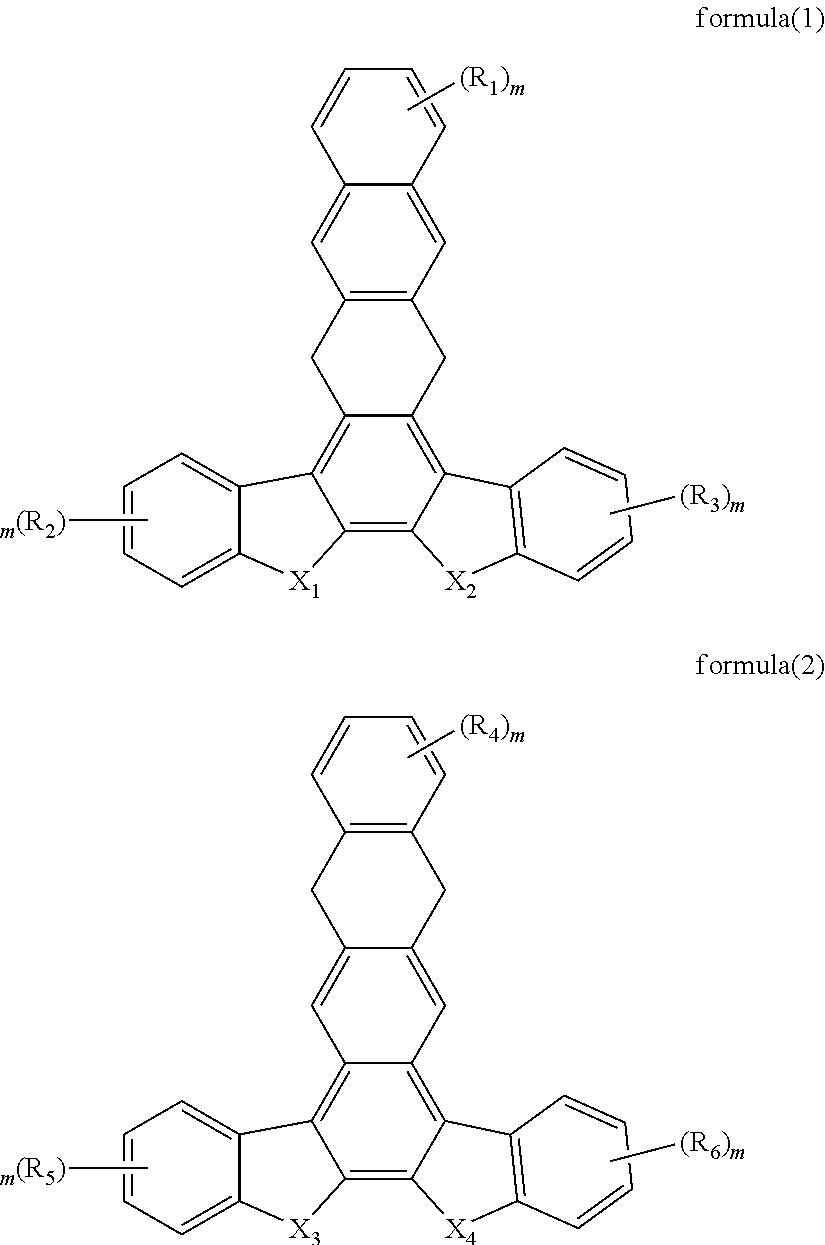Organic electroluminescent material and use thereof
- Summary
- Abstract
- Description
- Claims
- Application Information
AI Technical Summary
Benefits of technology
Problems solved by technology
Method used
Image
Examples
example 1
Synthesis of EX1
[0017]Synthesis of Intermediate I
[0018]A mixture of 34 g(500 mmol) of furan, 500 ml of 1.2-dimethoxy-ethane, was placed under nitrogen, and then heated to reflux, than 29.3 g(100 mmol) of 2-amino-3,6-dibromobenzoic acid, 11.7 g(100 mmol) of isopentyl nitrite was added to the mixture, and then stirred 1 hour. After finishing the reaction, the mixture was allowed to cool to room temperature. The solution was extracted with 250 ml of ethyl acetate and 1000 ml of water. The organic layer was dried with anhydrous magnesium sulfate and the solvent was evaporated under reduced pressure. The residue was purified by column chromatography on silica gel(hexane-dichloromethane) to give product 9.0 g(33.0 mmol, 33%).
[0019]Synthesis of Intermediate II
[0020]A mixture of 9 g(33 mmol) of intermediate I and 3.4 g(33 mmol) of 1,2-dihydrocyclobutabenzene was placed to the sealed tube and then heated to 220° C. for 6 hours. After finishing the reaction, the residue was purified by column...
example 2
Synthesis of EX2
[0031]
[0032]Under N2 condition, 16.5 g(23 mmol ) 5-phenyl-5,6,12,17-tetrahydroanthra[2,3-c]indolo[2,3-a]carbazole and 200 ml of DMF were mixed, and 4.4 g(184 mmol) of NaH was slowly added to the mixture. The mixture was stirred at room temperature for 30 minutes. Than 21.4 g(55.2 mmol) of 2-chloro-4,6-diphenyl-1,3,5-triazine was slowly added to the mixture. The mixture was stirred at room temperature for 24 hours. After completion of the reaction, 1000 ml of iced water was added, while stirring and the precipitated product was filtered off with suction. To give 6.0 g (yield31%) of yellow product which was recrystallized from ethyl acetate and purified by vacuum sublimation. MS(m / z, FAB+):715.2 ; 1H NMR (CDCl3, 500 MHz): chemical shift(ppm) 8.59˜8.54(m,2H), 8.43˜8.31(m,2H), 8.25˜8.21(m,2H), 8.14˜8.03 (m,3H), 7.86˜7.54(m, 5H), 7.47˜7.30(m, 9H), 7.05˜7.01(m, 5H), 6.85˜6.81 (m,1H), 4.05-3.98(m,4H).
example 3
[0033]Synthesis of Intermediate III
[0034]A mixture of 34 g(500 mmol ) of furan, 500 ml of 1.2-dimethoxyethane, was placed under nitrogen, and then heated to reflux, than 13.7 g(100 mmol) of 2-aminobenzoic acid, 11.7 g(100 mmol) of isopentyl nitrite was added to the mixture, and then stirred 1 hour. After finishing the reaction, the mixture was allowed to cool to room temperature the solution was extracted with 250 ml of ethyl acetate and 1000 ml of water. The organic layer was dried with anhydrous magnesium sulfate and the solvent was evaporated under reduced pressure. The residue was purified by column chromatography on silica gel(hexane-dichloromethane) to give product 5.9 g(41.0 mmol, 41%).
[0035]Synthesis of Intermediate IV
[0036]A mixture of 5.9 g(41 mmol) of intermediate III and 11.4 g (44 mmol) of 3,6-dibromo-1,2-dihydrocyclobutabenzene was placed to the sealed tube and then heated to 220° C. for 6 hours. After finishing the reaction, the residue was purified by column chromato...
PUM
 Login to View More
Login to View More Abstract
Description
Claims
Application Information
 Login to View More
Login to View More - R&D
- Intellectual Property
- Life Sciences
- Materials
- Tech Scout
- Unparalleled Data Quality
- Higher Quality Content
- 60% Fewer Hallucinations
Browse by: Latest US Patents, China's latest patents, Technical Efficacy Thesaurus, Application Domain, Technology Topic, Popular Technical Reports.
© 2025 PatSnap. All rights reserved.Legal|Privacy policy|Modern Slavery Act Transparency Statement|Sitemap|About US| Contact US: help@patsnap.com



